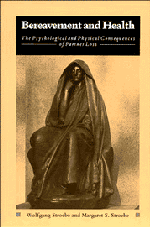Book contents
- Frontmatter
- Contents
- Preface
- 1 Introduction
- 2 The symptomatology of grief
- 3 Is grief universal? Cultural variations in the emotional reactions to loss
- 4 Depression models of grief
- 5 Stress models of grief
- 6 Mediators between stress and illness
- 7 The loss effect: health consequences of marital bereavement
- 8 Risk factors in bereavement outcome
- 9 Reducing the risk of poor bereavement outcome
- References
- Author index
- Subject index
4 - Depression models of grief
Published online by Cambridge University Press: 03 May 2010
- Frontmatter
- Contents
- Preface
- 1 Introduction
- 2 The symptomatology of grief
- 3 Is grief universal? Cultural variations in the emotional reactions to loss
- 4 Depression models of grief
- 5 Stress models of grief
- 6 Mediators between stress and illness
- 7 The loss effect: health consequences of marital bereavement
- 8 Risk factors in bereavement outcome
- 9 Reducing the risk of poor bereavement outcome
- References
- Author index
- Subject index
Summary
Introduction
That we should feel sad and depressed when we lose somebody we love is so self-evident that it does not seem in need of theoretical explanation. And yet, there are many aspects of grief which challenge our everyday understanding. It is difficult to comprehend, for example, that bereaved individuals are often so angry and aggressive that they alienate those who try to help them, or that some seem to search for the deceased, although they know that this is futile. A theory of grief should help one to understand these symptoms. It should also explain why the death of a loved person results in enduring physical and mental impairment for some people when the majority of bereaved individuals seem to be able to cope with the loss without such health deterioration. But, most importantly, a theory of grief should allow one to develop strategies of therapy to ameliorate or prevent pathological grief reactions.
There is no theory which fulfills all of these expectations. Traditionally, theories of grief have either focused on the emotional reaction to loss or on health consequences. Thus, grief theories can be divided into two groups according to their focus, namely depression models and stress models. Depression models, which will be described in this chapter, analyze grief as an emotional reaction to loss, although different approaches conceptualize the loss in different theoretical terms. Depression models help one to understand many of the emotional symptoms of the grief reaction.
- Type
- Chapter
- Information
- Bereavement and HealthThe Psychological and Physical Consequences of Partner Loss, pp. 56 - 76Publisher: Cambridge University PressPrint publication year: 1987



